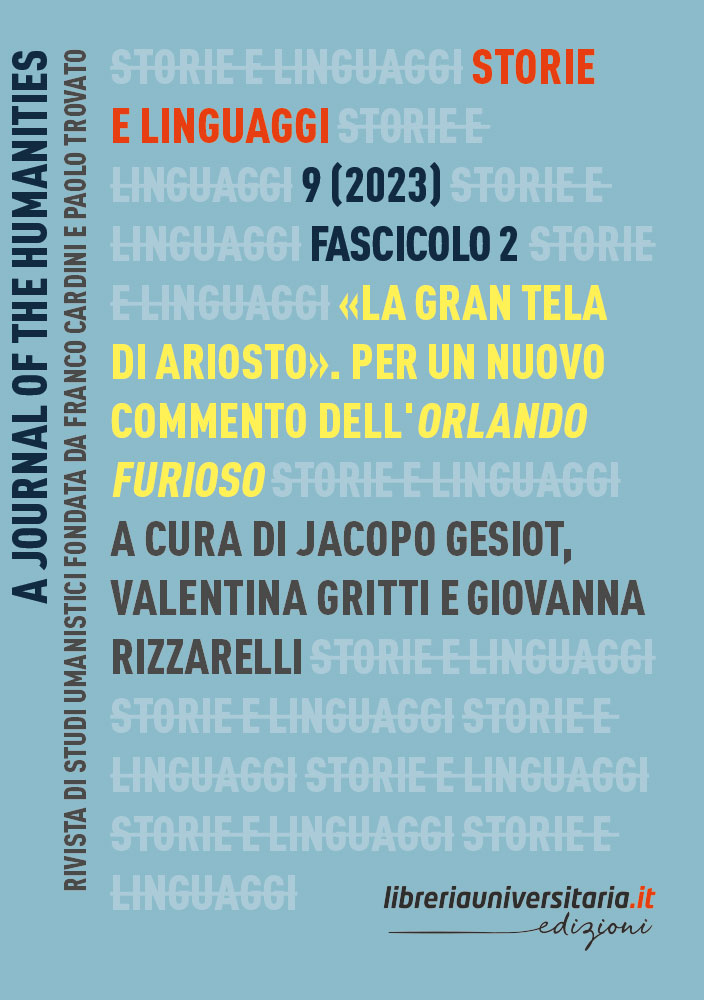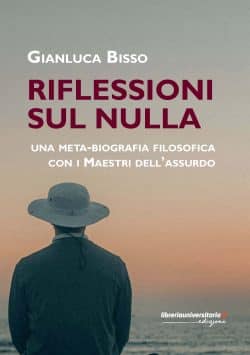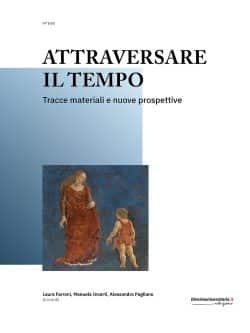Indice
Notes for a new commentary of the Furioso
ITA
L’intervento elenca alcuni aspetti essenziali da tenere presenti per un futuro commento dell’Orlando furioso: 1) il diverso approccio di Ariosto nei confronti delle fonti e dei modelli (i romanzi antico-francesi, i classici e l’Inamoramento de Orlando di Boiardo) e 2) il loro peso all’interno del singolo episodio; infine, 3) la risemantizzazione di elementi tematici o formali della tradizione romanza rispetto a quella classica e l’uso che Boiardo ne fa.
ENG
The paper lists some essential aspects to keep in mind for a future comment of Orlando furioso: 1) Ariosto’s different approach towards sources and models (French romances, classics and Boiardo’s Inamoramento de Orlando) and 2) their weight within the single episode; 3) the re-semantization of thematic or formal elements of the Romance tradition in relation to the classic one and the use that Boiardo makes of them.
«An admirable mixture of infinite memories». Ariosto’s imaginated library
ITA
In assenza di documenti che attestino di quali volumi fosse composta la biblioteca di Ariosto, una loro sopravvivenza o una loro effettiva riconoscibilità, l’articolo tenta di ricostruire il quadro culturale della circolazione dei libri che potrebbero essere giunti nelle mani del poeta. Si è pertanto individuato quali tipi di stampe di autori classici e moderni fossero vendute nelle botteghe dei cartolai ferraresi tra la fine del Quattrocento e il primo trentennio del Cinquecento. Inoltre, si è cercato di indicare a quali opere Ariosto potesse accedere grazie al prestito di amici come Alberto Pio da Carpi o Celio Calcagnini o attraverso la consultazione della biblioteca della corte estense e di quella della Cattedrale o, ancora, della biblioteca dei Gonzaga a Mantova. Inoltre, sono state almeno individuate le edizioni a cui Ariosto molto probabilmente ricorreva per alcuni autori (ad esempio, le aldine di Dante e Petrarca, il Mambriano, ecc.), pur senza la possibilità di identificarne gli esemplari effettivamente posseduti. Infine, l’articolo è corredato da un’appendice che riporta informazioni dettagliate su stampe e manoscritti che circolavano a Ferrara all’epoca di Ariosto o a cui il poeta avrebbe potuto accedere.
ENG
In the absence of documents attesting to which volumes Ariosto’s library consisted of or their survival. The article’s intention is to reconstruct the cultural framework of the book circulation that might have reached the poet’s hands. As such, we have identified which prints classical and modern authors were sold in Ferrara’s stationers workshops between the end of the fifteenth century and the first thirty years of the sixteenth century. Furthermore, we have attempted to indicate which texts Ariosto could have accessed thanks to the loan of friends such as Alberto Pio da Carpi or Celio Calcagnini or through consultation at the Este court library and that of the Cathedral or, even at the Gonzaga library in Mantua. Finally, we have identified the editions to which Ariosto most likely resorted for some authors (e.g., the Dante & Petrarch aldine, the Mambriano, etc.), although without the possibility of confirming the works specimen the poet actually owned. In addition, the article is accompanied by an appendix which details information about prints and manuscripts circulating in Ferrara at Ariosto’s time or that the poet might have accessed.
Following Virgil’s traces in the narrative structure of the Orlando furioso.
ITA
L’articolo segue le tracce di Virgilio attraverso la struttura narrativa del Furioso, rendendo conto dei meccanismi messi in atto da Ariosto per integrare la materia epica nella trama romanzesca. In particolare, l’analisi prende avvio dal racconto della battaglia di Parigi (canti XIV-XIX) e descrive l’inserimento dell’imitazione virgiliana nell’entrelacement, l’ibridazione di diverse fonti classiche e il loro adattamento all’ideologia e alla materia del poema. Nel portare poi lo sguardo sull’intera opera, viene notato un legame tra i riferimenti a Virgilio e la morte di diversi personaggi.
ENG
Starting from an analysis of the Battle of Paris (canti XIV-XIX), the article aims to describe the exploitation of Virgil’s plots and characters in the narrative construction of the poem.
The paper shows that Ariosto adapts his classical sources by absorbing them in the entrelacement and by freely hybridizing them. The existence of a link between the surfacing of imitations of Virgil in the Orlando furioso and the deaths of the main characters is also suggested.
«Armes et amours» before the Orlando furioso. Galloroman literary culture and the transformations of a medieval devise.
ITA
L’incipit del Furioso presuppone una fitta tessitura interdiscorsiva e intertestuale. Piuttosto che compilare un regesto delle possibili fonti e modelli, con il rischio di risultare al contempo incompleto e ridondante, questo contributo punta a definirne invece la sostanza tematica e retorica a partire dalla cultura letteraria soggiacente, in particolare galloromanza. L’analisi di un qualsiasi incipit solleva un numero di questioni, tre delle quali sono qui affrontate più estesamente: (1) origini e fortuna del binomio “armi e amori” nei testi galloromanzi; (2) la sua ricorrenza nelle aree liminari dei testi, autoriali, metaletterarie, del testo o del paratesto; (3) i modelli più diretti dell’Ariosto.
ENG
The beginning of the Furioso is noted for its complex intertwining of intertextual and interdiscursive elements. Rather than compiling a list of possible sources and models and risk incompleteness or redundancy, this essay takes on the matter of the Gallo-Romance tradition underlying it, also moving beyond conscious planning on the part of the author. Analysis of an incipit raises diverse issues, of which three are the focus of the present paper: (1) origins and fortune of the pair “armes et amours” in Gallo-Romance texts; (2) the expression’s recurrence in the liminal areas of texts: authorial or metaliterary, textual or paratextual; and (3) Ariosto’s most direct reference models.
«As Time takes from you, I engraft you new». The presence of Dante in Ariosto.
ITA
L’articolo indica alcune possibili direzioni di ricerca all’interno del già indagatissimo tema dell’intertestualità ariostesca in rapporto a Dante. In primo luogo, sarà possibile riflettere sulle scelte operate da Ariosto nell’ottica della ricezione dantesca in atto da parte dei contemporanei e per mezzo di Ariosto stesso. In secondo luogo, pare importante argomentare sulla funzione del riuso di Dante nel Furioso. Infine, particolari considerazioni potrebbero scaturire dall’esame delle fonti materiali dantesche su cui lavorava Ariosto: i paratesti e i testimoni, infatti, condizionano la lezione e l’interpretazione del testo.
ENG
The article indicates some possible research directions within the already highly investigated theme of Ariosto’s intertextuality in relation to Dante. First of all, it will be possible to reflect on the choices made by Ariosto with a view to the ongoing reception of Dante by his contemporaries and through Ariosto himself. Secondly, it seems important to argue about the function of Dante’s reuse in the Furioso. Finally, particular considerations could arise from the examination of Dante’s material sources on which Ariosto worked: indeed, the paratexts and the witnesses influence the lesson and the interpretation of the text.
Dante’s voice in Ariosto’s Orlando furioso: textual and quantitative remarks
ITA
Il saggio si sofferma sui principali lavori critici pubblicati dagli anni Sessanta del Novecento fino a oggi riguardo alle connessioni intertestuali tra le opere di Ariosto (e in particolare il Furioso) e la Commedia dantesca. L’attenzione dei critici si è dapprima soffermata sul riuso del lessico dantesco da parte di Ariosto (hapax, rime e serie di rime, fino a emistichi o a versi quasi interi in sequenza, perlopiù ricontestualizzati o sapientemente modificati). Maria Cristina Cabani ha definito parodico questo adattamento, giustificandolo con la necessità, da parte di Ariosto, di scegliere un registro narrativo distinto da quello di Dante. Per approfondire l’indagine sul rapporto intertestuale tra Furioso e Commedia è necessario cercare nuovi metodi: questo lavoro getta le basi per una ricognizione sulle microstrutture del testo, basata sui principi della linguistica testuale. Viene fornito un elenco dei versi inizianti per e e ma nel campione del I canto del Furioso: la struttura è infatti largamente usata da Dante (e da Ariosto) per scopi narrativi e prosodici. Segue un’analisi automatica tra il Furioso, la Liberata e due testi secenteschi, Il mondo nuovo di Stigliani e Il conquisto di Granata di Graziani. Tali statistiche mostrano che, contrariamente all’opinione comune, i narratori in versi del Seicento non sono meri imitatori di Tasso, ma tematicamente ritornano spesso alle parole chiave di Ariosto. E in filigrana compare anche Dante.
ENG
This paper provides a survey of the main critical works published from the 1960s to the present day, focusing on the intertextual connections between Ludovico Ariosto’s works (primarily Orlando furioso) and Dante’s Commedia. The critics’ attention has gradually shifted from lexical evidence, mainly including Dante’s hapaxes and rhymes or series of rhymes, to hemistiches or full verses and sequences of verses that are reviewed and reassembled in new contexts. This kind of adaptation was defined as parodic by Maria Cristina Cabani, who justifies this definition by discussing Ariosto’s attempt to obtain a distinct narrative register from Dante’s. Since a new investigation of Ariosto’s relationship with Dante’s text calls for new methods, this paper proposes a survey based on microstructures according to the approach of text linguistics. A preliminary analysis of the first canto of Orlando furioso provides significant data on the use of the conjunctions e and ma at the beginning of verses. This structure is widely used by both Dante and Ariosto for narrative and prosodic purposes. Secondly, an automatic analysis is illustrated of Ariosto’s poem compared to similar texts of the late 16th and 17th century: Tasso’s Gerusalemme liberata, Stigliani’s Il Mondo nuovo and Graziani’s Il Conquisto di Granata. Lexical statistics show that the authors of narrative poems in the 17th century did not merely imitate Tasso, but borrowed a number of lexical items from Ariosto. Intertextual data also points to the influence of Dante; consequently, prospective research will focus on lexical similarities between Dante and Ariosto, deriving from both direct influence or the mediation of other authors, mainly from the late 15th century.
On the trail of the Mambriano. Notes on the presence of Cieco da Ferrara in the Orlando furioso.
ITA
Il saggio indaga le influenze del Mambriano del Cieco da Ferrara sull’Orlando furioso. In primo luogo, queste vengono raccolte (facendo riferimento alla bibliografia precedente: essenzialmente Rajna e Segre) in una tabella, integrata con alcuni dettagli; poi vengono discusse le principali: l’incipit del poema ariostesco, l’episodio dell’isola di Alcina e l’episodio del castello di Atlante, sovrapponendo osservazioni sul motivo, sulla retorica e sui dettagli linguistici. Si è poi indagato anche su un peculiare trattamento del tema del labirinto (e dello spazio). Il fine è stato quello di individuare alcune costanti nel modo in cui il Mambriano viene ripreso dall’Ariosto.
ENG
The essay investigates the influences of Mambriano by Cieco da Ferrara on Orlando furioso. At first these are collected (referring to the previous bibliography: essentially Rajna and Segre) in a table, integrated with some details; then the main ones are discussed: the incipit of the Ariosto poem, the episode of Alcina’s island and the episode of Atlante’s castle, superimposing observations on the motif, rhetoric and linguistic details. A peculiar treatment of the theme of labyrinth (and space) was then also investigated. The aim was to identify some constants in the way the Mambriano is taken up by Ariosto.
Did Ariosto read novellas? The Orlando furioso and the developments of short prose narrative in the Quattrocento
ITA
L’obiettivo dell’articolo è quello di valutare le possibili influenze delle novelle quattrocentesche sull’Orlando furioso di Ariosto. Dopo una panoramica sugli sviluppi di questo genere letterario nel Quattrocento, si delinea il corpus testuale preso in considerazione per questa indagine. Si tratta del Novellino di Masuccio Salernitano e delle Porretane di Sabadino degli Arienti, le due principali raccolte autoriali che circolavano alla corte estense di Ferrara. Successivamente, la discussione si sposta a riflettere su cosa si possa definire “novella” all’interno del poema ariostesco, soprattutto alla luce dei cambiamenti avvenuti in questo genere letterario dopo Boccaccio. Infine, vengono proposti diversi parallelismi narrativi e tematici tra gli episodi dell’Orlando furioso e le novelle del XV secolo, evidenziando la necessità di considerare anche questo retroterra letterario per un nuovo commento del poema.
ENG
The aim of the paper is to assess the possible influences of 15th-century novellas on Ariosto’s Orlando furioso. After an overview of the developments of this literary genre in the Quattrocento, the textual corpus considered for this investigation is outlined. It consists of Masuccio Salernitano’s Novellino and Sabadino degli Arienti’s Porretane, the two main authorial collections which circulated in the Este court in Ferrara. Subsequently, the discussion turns to reflect on what can be defined as a “novella” within Ariosto’s poem, especially in light of the changes in this literary genre after Boccaccio. Finally, several narrative and thematic parallels are proposed between episodes of Orlando furioso and 15th-century novellas, highlighting the need to also consider this literary background for a new commentary of the poem.
The Orlando furioso and the lyric poetry of its time: echoes, intertexts, homages.
ITA
Sono stati molti gli studi che, anche in anni recenti, hanno indagato le influenze della poesia lirica nell’Orlando furioso, riflettendo talora sulle dinamiche di ibridazione fra generi, in altri casi, più nello specifico, sul rapporto di Ariosto con il sistema ideologico dei Rerum vulgarium fragmenta. Meno studiato è stato invece il contributo della poesia petrarchista coeva, anche per le difficoltà nel vagliarne l’entità distinguendolo da quello del modello petrarchesco. L’articolo imposta una prima indagine sul tema e suggerisce alcune linee di ricerca, invitando a considerare la possibile influenza di schemi retorici e formule tematiche che sembrano tipiche del petrarchismo quattro-cinquecentesco, nella sua declinazione amorosa ma anche morale. In conclusione ci si interroga su come il così aggiornato quadro delle fonti potrebbe riaprire, arricchendolo con nuovi spunti di riflessione, il dibattito critico sull’ironia ariostesca.
ENG
Several recent studies have tackled the issue of the influence on the Orlando furioso of the tradition of lyric poetry, mainly focussing either on the dynamics of intertwining different literary genres, or, more specifically, on Ariosto’s relationship with the ideological system of the Rerum vulgarium fragmenta. Less addressed has been the contribution of the lyric poetry contemporary to Ariosto, also due to the difficulties in pondering its extent and discerning it from that of Petrarch. This paper aims to offer a first insight into this point and suggest some possible lines of research, inviting to consider the possible influence of themes and rhetorical schemes that seem typical of early modern Petrarchism. In conclusion the question is raised on how the so-updated framework of sources may enrich (and possibly reshape) the critical concept of Ariostean irony.
«A imitatione del Boccaccio». Alberto Lavezola commentator of the Orlando furioso
ITA
L’attenzione e il successo immediato che il Furioso registrò presso i lettori e i critici è testimoniato anche dai commenti dei suoi contemporanei.
Oggetto privilegiato dell’analisi e dell’osservazioni di tali commentatori furono quelle che con un termine ottocentesco chiameremmo ‘fonti del Furioso’ e che erano rubricate, invece, sotto il termine eloquente di imitationi. Secondo il principio aureo dell’imitatio, la grandezza di Ariosto e della sua opera sarebbe stata attestata dalla raffinata ripresa di modelli classici (Virgilio e Ovidio, in primo luogo).
In un panorama ricco ma per tanti versi omogeneo, spiccano le Osservationi del signor Alberto Lavezuola sopra il Furioso, che accompagnano l’edizione del poema impressa da Francesco de Franceschi nel 1584. Il commento di Lavezola si allontana da quelli dei suoi predecessori e riserva particolare attenzione all’Ariosto lettore ed estimatore dei classici volgari (Dante e Boccaccio, in primis).
L’intervento intende dunque offrire un’analisi della prassi di commento del Lavezola, concentrandosi su quella che egli stesso definisce l’«imitatione del Boccaccio». Molti dei rimandi intertestuali suggeriti dal Lavezola contribuiscono, infatti, a mettere a fuoco un’ulteriore tessera della variegata memoria poetica di Ariosto e aggiungono nuovi elementi per comprendere le sue straordinarie doti di lettore e ‘imitatore’ di antichi e moderni.
Abstract (eng)
The immediate attention and success that the Furioso registered among readers and critics is also evidenced by the commentaries of its contemporaries.
The privileged object of such commentators’ analysis and observations were what with a nineteenth-century term we would call ‘sources of the Furioso’ and which were rubricated, instead, under the eloquent term of ‘imitationi’. According to the golden principle of imitatio, the greatness of Ariosto and his work would have been attested by the refined revival of classical models (Virgil and Ovid, primarily).
In a rich but in many ways homogeneous panorama, Lavezola’s Osservationi sopra il Furioso, which accompanied the edition of the poem impressed by Francesco de Franceschi in 1584, stands out. Lavezola’s commentary departs from those of his predecessors and pays special attention to Ariosto as a reader and admirer of the vernacular classics (Dante and Boccaccio, in primis).
The paper therefore aims to offer an analysis of Lavezola’s commentary practice, focusing on what he calls the “imitation of Boccaccio”. Indeed, many of the intertextual references suggested by Lavezola help to shed light on a further tessera of Ariosto’s variegated poetic memory and add new elements for understanding his extraordinary gifts as a reader and ‘imitator’ of ancients and moderns.
The Orlando furioso in the Commentaria symbolica by Antonio Ricciardi
ITA
Il contributo analizza la presenza dell’Orlando furioso di Ariosto nel primo dizionario dei simboli del Rinascimento, i Commentaria Symbolica di Antonio Ricciardi (Venezia, 1591). Ricciardi attinge a un gran numero di fonti, ma l’Orlando furioso di Ariosto è il poema in volgare in assoluto più citato: si ritiene pertanto che l’Orlando furioso di Ariosto fosse particolarmente adatto a essere incluso tra le fonti di Ricciardi sui simboli proprio per l’allegorizzazione abituale a cui era sottoposto nelle edizioni a stampa di fine del Cinquecento. Infatti, Ricciardi fa spesso riferimento alle allegorie di Valvassori, e occasionalmente anche a quelle di Dolce. Infine, i riferimenti espliciti all’Ariosto in un’opera così enciclopedica indicano la sua autorità e il suo prestigio come classico moderno da tempo canonizzato.
ENG
This contribution analyzes the presence of Ariosto’s Orlando furioso in the first dictionary of symbols of the Renaissance, Antonio Ricciardi’s Commentaria Symbolica (Venice, 1591). Ricciardi draws from a large number of sources, but Ariosto’s Orlando furioso is the only vernacular poem heavily quoted: we argue that Ariosto’s Orlando furioso was particularly apt for being included among
Ricciardi’s sources about symbols due to its allegorization, which by the end of the Sixteenth century was a customary component in printed editions of the poem. In fact, Ricciardi often refers to Valvassori’s allegories, and occasionally to Dolce’s. Moreover, explicit references to Ariosto in such an encyclopedic work indicates its authority and its prestige as a canonized modern classic.
Critical considerations on Orlando furioso comments between the 19th and the end of 20th century
ITA
Il presente lavoro è incentrato sull’esame dei commenti all’Orlando furioso (1532) di Ariosto, pubblicati negli ultimi centocinquant’anni. Si sofferma sullo sviluppo delle note di commento, in rapporto con la critica letteraria dalla fine dell’Ottocento a tutto il Novecento. Analizza dapprima le edizioni di fine Ottocento e poi considera l’effetto del pensiero di Benedetto Croce su quelle dell’inizio del Novecento. Infine, concentra l’attenzione sui commenti della seconda metà del secolo scorso, evidenziando le caratteristiche più importanti delle principali edizioni, come quelle di Caretti (1954), Ceserani (1962), Segre (1964) ed Emilio Bigi (1982), in modo da definire gli orientamenti esegetici di questi importanti studi.
ENG
This paper is focused on the exam of the commentaries to Ariosto’s Orlando furioso (1532), which were published in the last one hundred and fifty years. It dwells on the development of the commentary notes, in relationship with the literary critics between the end of nineteenth and the whole twentieth century. Firstly, it analyses the late nineteenth-century editions and then it considers the effect of Benedetto Croce’s thought at the beginning of the twentieth century. At last, it focuses the attention on the second half of the last century, highlighting the most important features of the main editions, such as Caretti (1954), Ceserani (1962), Segre (1964) and Emilio Bigi (1982). At the end it will be possible to define the exegetical guidelines of these important studies.
Ludovico Ariosto in an unknown ledger from Garfagnana.
ITA
Tra i numerosi manoscritti della collezione Fry, conservati nella biblioteca dell’Università del Wisconsin a Madison, c’è un “Libro Mastro” di mano di ser Costantino da Castelnuovo di Garfagnana. Il libro registra le entrate e le uscite del dominio degli Este in Garfagnana e copre un periodo di oltre sei anni (dall’ultimo trimestre del 1524 all’ultimo trimestre, compreso, del 1530). Tre sono i commissari generali coinvolti il cui governo è trattato nel volume: Ludovico Ariosto, Cesare Cattani e Agostino Bellencino. Il libro mastro è quindi un documento estremamente importante, non solo perché rappresenta un pezzo di storia della Garfagnana, ma anche e soprattutto perché tocca gli ultimi otto mesi del commissariato di Ludovico Ariosto.
ENG
Among the several manuscripts of the Fry collection, preserved in the library of the University of Wisconsin in Madison, there is a “Libro Mastro” (a ledger) by the hand of ser Costantino from Castelnuovo di Garfagnana. This ledger deals with the income and the expenses of the Garfagnana under the rule of the Este, and it covers a period of more than six years (from the last quarter of 1524 to the last quarter, inclusive, of 1530). As such it concerns three general commissioners: Ludovico Ariosto, Cesare Cattani and Agostino Bellencino. Therefore, this ledger is an extremely important document, not only because it represents a piece of the history of Garfagnana, but also and above all because it concerns the last eight months of Ludovico Ariosto’s commissariat.





